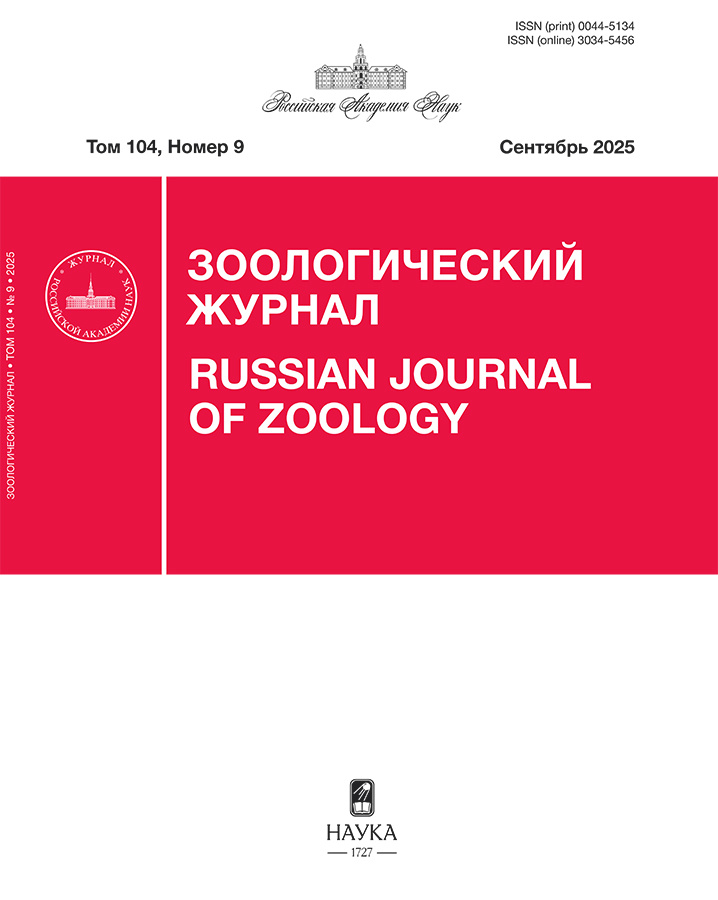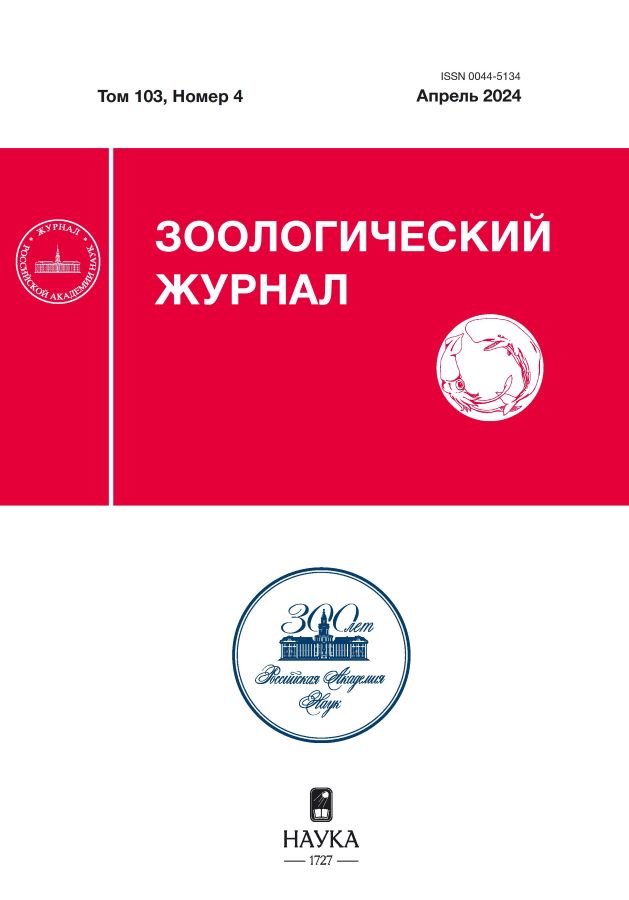Генетические линии Parisotoma notabilis sensu lato (Hexapoda, Collembola) и их использование в биологическом мониторинге
- Авторы: Стрючкова А.В.1, Кузнецова Н.А.1
-
Учреждения:
- Московский педагогический государственный университет
- Выпуск: Том 103, № 4 (2024)
- Страницы: 44-52
- Раздел: Статьи
- URL: https://rjeid.com/0044-5134/article/view/654294
- DOI: https://doi.org/10.31857/S0044513424040053
- EDN: https://elibrary.ru/UYDGPI
- ID: 654294
Цитировать
Полный текст
Аннотация
Широко распространенные виды мелких почвенных членистоногих традиционно используют в биологическом мониторинге состояния окружающей среды. Перспективным развитием этого направления может стать использование генетических методов, а именно состава генетических линий в популяциях политипических видов. К таким видам относится коллембола Parisotoma notabilis sensu lato, особенно многочисленная в Европе. На сегодня известно 6 линий этого комплекса, генетические дистанции между которыми близки к видовым. Ранее нами была показана дифференцировка этих линий в градиенте урбанизации (природный лес – лесопарк – городской газон) на примере Московского региона. В данной работе дивергенция генетических линий по этим местообитаниям была подтверждена для различных природных зон. Минимально нарушенные местообитания маркируют линии L2, L4-Hebert и L0, наиболее нарушенные – L1. Мониторинг изменений в почвенном ярусе экосистем возможен лишь в зонах симпатрии различных генетических линий P. notabilis, т.е. районах их совместной встречаемости. Согласно полученным данным, к таким территориям относится, по-видимому, вся европейская часть России.
Ключевые слова
Полный текст
Об авторах
А. В. Стрючкова
Московский педагогический государственный университет
Email: astr2502@yandex.ru
Россия, Москва
Н. А. Кузнецова
Московский педагогический государственный университет
Автор, ответственный за переписку.
Email: mpnk@yandex.ru
Россия, Москва
Список литературы
- Антипова М.Д., Бабенко А.Б., 2023. Формирование сообществ коллембол (Hexapoda, Collembola) при отступании Цейского ледника (Северная Осетия – Алания) // Зоологический журнал. Т. 102. № 12. C. 1370–1388. https://doi.org/10.31857/S0044513423120036
- Кузнецова Н.А., 2005. Организация сообществ почвообитающих коллембол. М.: Прометей. 244 с.
- Потапов М.Б., 2022. Поиск морфологических различий между генетическими линиями видов-убиквистов – насущная задача систематики коллембол // Биота, генезис и продуктивность почв. Материалы XIX Всероссийского совещания по почвенной зоологии. Под редакцией А.В. Тиунова, К.Б. Гонгальского, А.В. Уварова. Улан-Удэ: Бурятский научный центр Сибирского отделения РАН. С. 130–131.
- Стрючкова А.В., Кузнецова Н.А., 2023. Экотипы широкораспространенных видов: перспектива использования в экологическом мониторинге // Биодиагностика и экологическая оценка окружающей среды: современные технологии, проблемы и решения. Материалы IV международного симпозиума. Отв. ред. Терехова В.А., Кулачкова С.А., Ковалева Е.И. М.: Научная библиотека МГУ. С. 227–231. https://doi.org/10.61271/j8240-4277-2929-x
- Чернова Н.М., Потапов М.Б., Савенкова Ю.Ю., Бокова А.И., 2009. Экологическая роль партеногенеза у коллембол // Зоологический журнал. Т. 88. № 12. С. 1455–1470.
- Шарин В.Г., 2004. Группировка ногохвосток (Collembola) свалки бытовых отходов Подмосковья // Зоологический журнал. Т. 83. № 12. С. 1419– 1426.
- Шеховцов С.В., Ермолов С.А., Держинский Е.А., Полубоярова Т.В., Ларичева М.С., Пельтек С.Е., 2020. Генетическая и размерная изменчивость Octolasion tyrtaeum (Lumbricidae, Annelida) // Письма в Вавиловский журнал генетики и селекции. Т. 6. № 1. С. 5–9. https://doi.org/10.18699/Letters2020-6-01
- Anslan S., Tedersoo L., 2015. Performance of cytochrome c oxidase subunit I (COI), ribosomal DNA Large Subunit (LSU) and Internal Transcribed Spacer 2 (ITS2) in DNA barcoding of Collembola // European Journal of Soil Biology. V. 69. P. 1–7. https://doi.org/10.1016/j.ejsobi.2015.04.001
- Bahrndorff S., Loeschcke V., Pertoldi C., Beier C., Holmstrup M., 2009. The rapid cold hardening response of Collembola is influenced by thermal variability of the habitat // Functional Ecology. V. 23. P. 340–347. https://doi.org/10.1111/j.1365-2435.2008.01503.x
- Connell J.H., 1978. Diversity in tropical rain forests and coral reefs: high diversity of trees and corals is maintained only in a nonequilibrium state // Science. V. 199. № 4335. P. 1302–1310. https://doi.org/10.1126/science.199.4335.1302
- Connell J.H., Hughes T.P., Wallace C.C., 1997. A 30-year study of coral abundance, recruitment, and Disturbance at several scales in space and time // Ecological Monographs. V. 67. № 4. P. 461–488. https://doi.org/10.2307/2963466
- Culliney T.W., 2013. Role of arthropods in maintaining soil fertility // Agriculture. V. 3. № 4. P. 629–659. https://doi.org/10.3390/agriculture3040629
- Deiner K., Bik H.M., Mächler E., Seymour M., Lacoursière-Roussel A., et al., 2017. Environmental DNA metabarcoding: Transforming how we survey animal and plant communities // Molecular Ecology. V. 26. № 21. P. 5872–5895. https://doi.org/10.1111/mec.14350
- Dopheide A., Xie D., Buckley T.R., Drummond A.J., Newcomb R.D., 2019. Impacts of DNA extraction and PCR on DNA metabarcoding estimates of soil biodiversity // Methods in Ecology and Evolution. V. 10. № 1. P. 120– 133. https://doi.org/10.1111/2041-210X.13086
- Fernandes K., van der Heyde M., Bunce M., Dixon K., Harris R.J., et al., 2018. DNA metabarcoding – a new approach to fauna monitoring in mine site restoration // Restoration Ecology. V. 26. № 6. P. 1098–1107. https://doi.org/10.1111/rec.12868
- Fjellberg A., 2007. The Collembola of Fennoscandia and Denmark, Part II: Entomobryomorpha and Symphypleona. Fauna Entomologica Scandinavica. V. 42. Brill. 264 p.
- Frumkin H., 2016. Environmental health: from global to local. San Francisco: John Wiley & Sons. 896 p.
- Geisen S., 2021. Molecular approaches to revolutionize soil biodiversity monitoring // Soil biodiversity from the lowlands to the high mountains: the XVIII International Colloquium on Soil Zoology and XV International Colloquium on Apterygota. Eurac Research, Bozen/Bolzano, Italy. P. 44.
- Ji Y., Ashton L., Pedley S.M., Edwards D.P., Tang Y. et al., 2013. Reliable, verifiable and efficient monitoring of biodiversity via metabarcoding // Ecology Letters. V. 16. № 10. P. 1245–1257. https://doi.org/10.1111/ele.12162
- Linhart Y.B., Grant M.C., 1996. Evolutionary significance of local genetic differentiation in plants // Annual Review of Ecology and Systematics. V. 27. № 1. P. 237–277.
- McKinney M.L., 2008. Effects of urbanization on species richness: A review of plants and animals // Urban Ecosystem. V. 11. P. 161–176. https://doi.org/10.1007/s11252-007-0045-4
- Menta C., Remelli S., 2020. Soil health and arthropods: from complex system to worthwhile Investigation // Insects. V. 11. № 1. P. 54. https://doi.org/10.3390/insects11010054
- Orgiazzi A., Bardgett R.D., Barrios E., Behan-Pelletier V., Briones M.J.I., et al., 2016. Global soil biodiversity atlas. European Commission. 176 p.
- Orgiazzi A., Dunbar M.B., Panagos P., de Groot G.A., Lemanceau P., 2015. Soil biodiversity and DNA barcodes: opportunities and challenges // Soil Biology and Biochemistry. V. 80. P. 244–250. https://doi.org/10.1016/j.soilbio.2014.10.014
- Pfingstl T., Lienhard A., Baumann J., Koblmüller S., 2021. A taxonomist’s nightmare – Cryptic diversity in Caribbean intertidal arthropods (Arachnida, Acari, Oribatida) // Molecular Phylogenetics and Evolution. V. 163. 107240. https://doi.org/10.1016/j.ympev.2021.107240
- Phillips H.R.P., Guerra C.A., Bartz M.L.C., Briones M. J. I., Brown G. et al., 2019. Global distribution of earthworm diversity // Science. V. 366. № 6464. P. 480–485. https://doi.org/10.1126/science.aax4851
- Porco D., Bedos A., Greenslade P., Janion C., Skarżyński D. et al., 2012. Challenging species delimitation in Collembola: cryptic diversity among common springtails unveiled by DNA barcoding // Invertebrate Systematics. V. 26. P. 470–477. https://doi.org/10.1071/IS12026
- Porco D., Potapov M., Bedos A., Busmachiu G., Weiner W.M. et al., 2012a. Cryptic diversity in the ubiquist species Parisotoma notabilis (Collembola, Isotomidae): a long-used chimeric species? // PLOS ONE. V. 7. e46056. https://doi.org/10.1371/journal.pone.0046056
- Potapov A.M., Guerra C.A., van den Hoogen J. et al., 2023. Globally invariant metabolism but density-diversity mismatch in springtails // Nature Communications. V. 14. № 674. P. 1–13.
- Potapov M., 2001. Synopses on Palaearctic Collembola: Isotomidae. Senckenberg Museum of Natural History Görlitz. 603 p.
- Potapov M.B., Kuznetsova N.A., Janion-Scheepers C., Bokova A.I., Panina K.S., 2021. Alien species of Collembola in agroecosystems in the European part of Russia // Borok-VI: sixth International Symposium – Invasion of Alien Species in Holarctic. Kazan. Buk. P. 184.
- Prendini L., Weygoldt P., Wheeler W.C., 2005. Systematics of the Damon variegatus group of African whip spiders (Chelicerata: Amblypygi): Evidence from behaviour, morphology and DNA // Organisms Diversity and Evolution. V. 5. № 3. P. 203–236. https://doi.org/10.1016/j.ode.2004.12.004
- Rusek J., 2004. Collembola succession on deposits from a chemical factory // Pedobiologia. V. 48. № 5–6. P. 519–525. https://doi.org/10.1016/j.pedobi.2004.06.008
- Saltzwedel H., Scheu S., Schaefer I., 2017. Genetic structure and distribution of Parisotoma notabilis (Collembola) in Europe: Cryptic diversity, split of lineages and colonization patterns // PLOS ONE. V. 12. e0170909. https://doi.org/10.1371/journal.pone.0170909
- Saltzwedel H. von, Maraun M., Scheu S., Schaefer I., 2014. Evidence for frozen-niche variation in a cosmopolitan parthenogenetic soil mite species (Acari, Oribatida) // PLOS ONE. V. 9. e113268. https://doi.org/10.1371/journal.pone.0113268
- Schäffer S., Kerschbaumer M., Koblmüller S., 2019. Multiple new species: Cryptic diversity in the widespread mite species Cymbaeremaeus cymba (Oribatida, Cymbaeremaeidae) // Molecular Phylogenetics and Evolution. V. 135. P. 185–192. https://doi.org/10.1016/j.ympev.2019.03.008
- Shekhovtsov S.V., Ershov N.I., Vasiliev G.V., Peltek S.E., 2019. Transcriptomic analysis confirms differences among nuclear genomes of cryptic earthworm lineages living in sympatry // BMC Evolutionary Biology. V. 19. Suppl. 1: 50. P. 13–22. https://doi.org/10.1186/s12862-019-1370-y
- Spellerberg I.F., 2005. Monitoring Ecological Change. Cambridge: Cambridge University Press. 411 p.
- Striuchkova A., 2023. Distribution of genetic lineages of Parisotoma notabilis (Collembola) in the urbanistic gradient // Russian Journal of Ecology. V. 54. P. 347–351. https://doi.org/10.1134/S1067413623040112
- Striuchkova A., Malykh I., Potapov M., Kuznetsova N.A., 2022. Sympatry of genetic lineages of Parisotoma notabilis s. l. (Collembola, Isotomidae) in the East European Plain // ZooKeys. V. 1137. P. 1–15. https://doi.org/10.3897/zookeys.1137.95769
- Stronen A.V., Norman A.J., Vander Wal E., Paquet P.C., 2022. The relevance of genetic structure in ecotype designation and conservation management // Evolutionary Applications. V. 15. № 2. P. 185–202. https://doi.org/10.1111/eva.13339
- Sun X., Bedos A., Deharveng L., 2018. Unusually low genetic divergence at COI barcode locus between two species of intertidal Thalassaphorura (Collembola: Onychiuridae) // PeerJ. V. 6. e5021. https://doi.org/10.7717/peerj.5021
- Taberlet P., Coissac E., Pompanon F., Brochmann C., Willerslev E., 2012. Towards next-generation biodiversity assessment using DNA metabarcoding // Molecular Ecology. № 8. V. 21. P. 2045–2050. https://doi.org/10.1111/j.1365-294X.2012.05470.x
- Turesson G., 1922. The genotypical response of the plant species to the habitat // Hereditas. V. 3. № 3. P. 211–350. https://doi.org/10.1111/j.1601-5223.1922.tb02734.x
- Wanner M., Dunger W., 2002. Primary immigration and succession of soil organisms on reclaimed opencast coal mining areas in eastern Germany // European Journal of Soil Biology. V. 38. № 2. P. 137–143. https://doi.org/10.1016/S1164-5563(02)01135-4
- Whiting M.F., 2002. Mecoptera is paraphyletic: multiple genes and phylogeny of Mecoptera and Siphonaptera // Zoologica Scripta. V. 31. № 1. P. 93–104. https://doi.org/10.1046/j.0300-3256.2001.00095.x
- Yang Ch., Wang X., Miller J.A., de Blécourt M., Ji Y., et al., 2014. Using metabarcoding to ask if easily collected soil and leaf-litter samples can be used as a general biodiversity indicator // Ecological Indicators. V. 46. P. 379–389. https://doi.org/10.1016/j.ecolind.2014.06.028
- Zhang B., Chen T.-W., Mateos E., Scheu S., Schaefer I., 2018. Cryptic species in Lepidocyrtus lanuginosus (Collembola: Entomobryidae) are sorted by habitat type // Pedobiologia. V. 68. P. 12–19. https://doi.org/10.1016/j.pedobi.2018.03.001
Дополнительные файлы

















